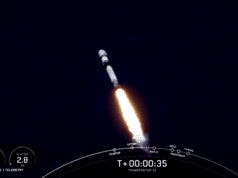
The ABI has experienced technical issues with its cooling system during the orbital check-out phase of GOES-17’s six instruments — the other five are performing normally. The cooling system is a significant part of the ABI and did not start up properly.
In a teleconference with the media, NOAA officials said they had been able to improve the availability of infrared and near-infrared channels on the Advanced Baseline Imager (ABI) instrument on the GOES-17 satellite since the agency first reported the problem two months ago. The spacecraft, originally known as GOES-S, was launched in March.
“ABI is already demonstrating improved performance from what was initially observed,” said Pam Sullivan, director of the GOES-R system program. Currently, 13 of the instrument’s 16 channels are available 24 hours a day, with the other three able to operate at least 20 hours a day.
That will change, though, on a seasonal basis, depending on the amount of sunlight that shines into the instrument. By September, the hottest part of the orbit, only 10 of 16 channels will be available 24 hours a day, she said, with the other six available “most of the day.”
As one team works to improve the performance of the ABI on GOES-17, another team is tracking down the root cause of the instrument. Sullivan said the issue appears to be with loop heat pipes that contain propylene coolant. “It doesn’t seem to be flowing appropriately through the loops,” she said.
She said that team has identified a “small handful” of likely causes for the lack of coolant flow. They include “excess non-condensable gas” or foreign object debris in the pipes. “Either one of those might prevent the fluid from traveling through the loop heat pipe as intended,” she said. There could also be mechanical damage to the pipes.
When NOAA first announced the problem with the ABI on GOES-17 in May, the agency said they did not see a similar problem with an identical instrument on GOES-16, the first of the GOES-R series of next-generation weather satellites launched in 2016. However, Sullivan said that, since then, engineers have seen “some evidence of reduced functionality” in the loop heat pipes in that spacecraft’s ABI, but one that has not affected the performance of the instrument.




